Postcards from the Field March 2007
As part of the 200th Celebration, we have asked staff from around NOAA to send in their "Postcards from the Field." A "postcard" is a photo from a NOAA field office, science center, or any site on the globe where NOAA is conducting research or field work. The postcard includes—anywhere in the shot—a NOAA 200th emblem or banner.
For more information about "Postcards from the Field," including details about how to participate, please contact David.P.Miller@noaa.gov.
This creative collection of images showcases the breadth and span of NOAA's work...whether it involves conducting research at the South Pole, surveying the ocean floor in Alaska, or flying into hurricanes, NOAA is there. Click on the arrows to browse through postcards submitted thus far.


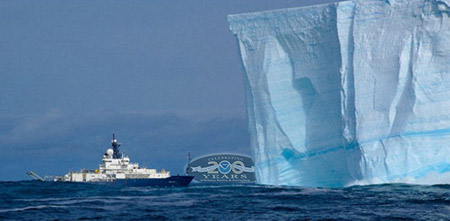 In mid-February, the crew of the R/V Roger Revelle came nose-to-nose with an
Antarctic iceberg floating in the Indian Ocean sector of the Southern Ocean. NOAA researchers David Wisegarver, Eric Wisegarver, Dana Greeley, Robert Castle, Geoff
Lebon, and Esa Peltola are participating in a research effort co-sponsored by NOAA and the National Science Foundation as part of the CLIVAR/CO2 Repeat Hydrography
Program. This research involves studying changes over the past decade in the chemical make-up of the ocean, in particular quantifying how much carbon dioxide, a
major greenhouse gas, is absorbed by the ocean. CLIVAR, which stands for Climate Variability and Predictability, is an international research program.
In mid-February, the crew of the R/V Roger Revelle came nose-to-nose with an
Antarctic iceberg floating in the Indian Ocean sector of the Southern Ocean. NOAA researchers David Wisegarver, Eric Wisegarver, Dana Greeley, Robert Castle, Geoff
Lebon, and Esa Peltola are participating in a research effort co-sponsored by NOAA and the National Science Foundation as part of the CLIVAR/CO2 Repeat Hydrography
Program. This research involves studying changes over the past decade in the chemical make-up of the ocean, in particular quantifying how much carbon dioxide, a
major greenhouse gas, is absorbed by the ocean. CLIVAR, which stands for Climate Variability and Predictability, is an international research program.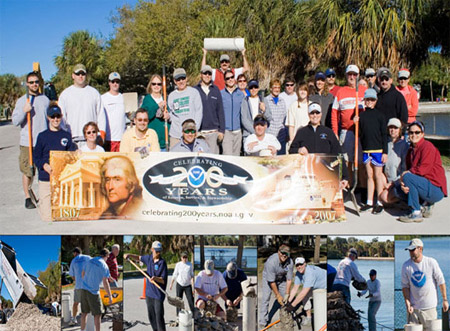 200th anniversary greetings arrived from Tampa Bay, Florida, where
NOAA staff joined with habitat restoration partner Tampa Bay Watch for two days of oyster-reef building. Staff from the NOAA Fisheries Southeast Regional Office,
the National Ocean Service’s Office of Response and Restoration, and the NOAA Restoration Center pitched in to bag and deploy 22 tons of oyster shell. They created
four new oyster bars totaling 330 linear feet. Deployed by hand and transported by boat, individually filled oyster bags shape the new reefs. Each bag weighs
about 30 pounds and 1,500 bags were filled to deploy the 22 tons. In about 18 months, the oysters will settle and mature on the newly created reef, improving
water quality, stabilizing the shoreline, and providing nursery habitat for fish and shellfish vital to commercial and recreational fishing.
200th anniversary greetings arrived from Tampa Bay, Florida, where
NOAA staff joined with habitat restoration partner Tampa Bay Watch for two days of oyster-reef building. Staff from the NOAA Fisheries Southeast Regional Office,
the National Ocean Service’s Office of Response and Restoration, and the NOAA Restoration Center pitched in to bag and deploy 22 tons of oyster shell. They created
four new oyster bars totaling 330 linear feet. Deployed by hand and transported by boat, individually filled oyster bags shape the new reefs. Each bag weighs
about 30 pounds and 1,500 bags were filled to deploy the 22 tons. In about 18 months, the oysters will settle and mature on the newly created reef, improving
water quality, stabilizing the shoreline, and providing nursery habitat for fish and shellfish vital to commercial and recreational fishing.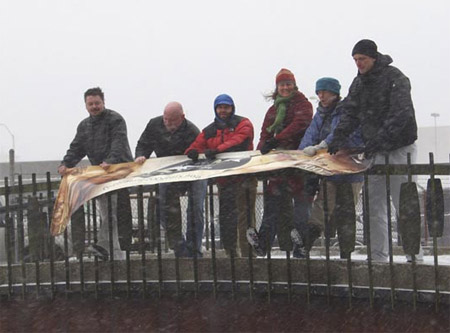 200th celebration greetings from our intrepid NOAA Fisheries, Alaska Region staff in
Juneau. Shown as they battled high winds and blowing snow to display the 200th banner are (from left): Clay Robidoux, Scott Balovich, Ron Antaya, Marina Lindsey,
Sheela McLean, and Pete Jones.
200th celebration greetings from our intrepid NOAA Fisheries, Alaska Region staff in
Juneau. Shown as they battled high winds and blowing snow to display the 200th banner are (from left): Clay Robidoux, Scott Balovich, Ron Antaya, Marina Lindsey,
Sheela McLean, and Pete Jones.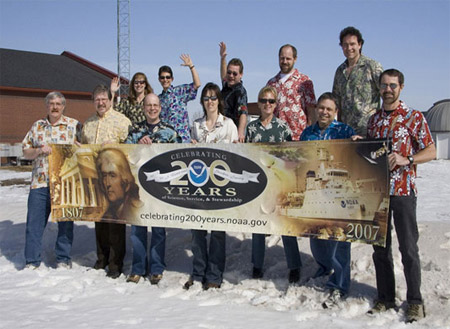 After a season of blizzards, winter storms, and bitter cold, NOAA's National
Weather Service team in Bismarck, North Dakota, celebrated some "balmy" weather with tropical attire and warm smiles. "We want to show folks how we surf in North
Dakota," they wrote. Shown in the front row (from the left): Bill Abeling, Vic Jensen, Todd Hamilton, Nadine Glur, Charlene Prindiville, Rich Leblang, and Len Peterson,
and in the back row (from the left): Becky Selzler, Janine Vining, Jim Meyer, Dave Derung, and Paul Waliser.
After a season of blizzards, winter storms, and bitter cold, NOAA's National
Weather Service team in Bismarck, North Dakota, celebrated some "balmy" weather with tropical attire and warm smiles. "We want to show folks how we surf in North
Dakota," they wrote. Shown in the front row (from the left): Bill Abeling, Vic Jensen, Todd Hamilton, Nadine Glur, Charlene Prindiville, Rich Leblang, and Len Peterson,
and in the back row (from the left): Becky Selzler, Janine Vining, Jim Meyer, Dave Derung, and Paul Waliser.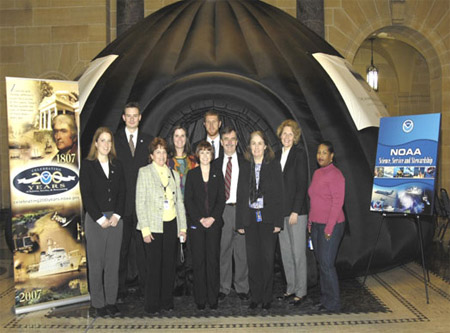 NOAA's Education Office recently sponsored a demonstration of imagery and data
visualization in the U.S. Department of Commerce lobby. Interactive with the sense of being underwater, the exhibit offers a chance to more fully engage students
and the public in science education. NOAA imagery included coral reefs from the Northwestern Hawaiian Islands Marine National Monument and deep-sea hydrothermal
vents filmed by Woods Hole Oceanographic Institutions. Shown (from left): Alyssa Gundersen, Jon Lilley, Einstein Fellow Judy Reeves, Kim Benson, Carrie McDougall,
John McLaughlin, Bob Hansen, Marlene Kaplan, Pam Polmateer, and Peaches Hodge.
NOAA's Education Office recently sponsored a demonstration of imagery and data
visualization in the U.S. Department of Commerce lobby. Interactive with the sense of being underwater, the exhibit offers a chance to more fully engage students
and the public in science education. NOAA imagery included coral reefs from the Northwestern Hawaiian Islands Marine National Monument and deep-sea hydrothermal
vents filmed by Woods Hole Oceanographic Institutions. Shown (from left): Alyssa Gundersen, Jon Lilley, Einstein Fellow Judy Reeves, Kim Benson, Carrie McDougall,
John McLaughlin, Bob Hansen, Marlene Kaplan, Pam Polmateer, and Peaches Hodge.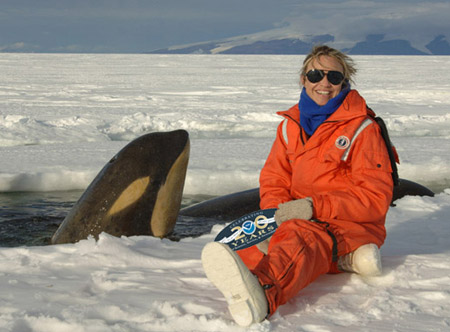 For several years, Bob Pitman, a marine ecologist at NOAA's Southwest Fisheries Science
Center, has been conducting research with NOAA's National Marine Fisheries Service and other colleagues with the aim of discovering whether there may be a new species of
killer whale in the waters of Antarctica. Genetics, aerial photogrammetry, and satellite telemetry are being used to explore the possibility. In addition to NOAA, work
is supported by a number of agencies, including the National Science Foundation, Marine Mammal Commission, and National Geographic Society. The research is part of the
broader NOAA Fisheries' mandate to monitor the status of protected species and identify populations requiring management attention. Here, NOAA marine ecologist Lisa
Ballance is shown in the southern Ross Sea, Antarctica, at a site where NOAA satellite-tagged one of the local forms of killer whales. This calf may be a new species of
killer whale living in the ice in that region.
For several years, Bob Pitman, a marine ecologist at NOAA's Southwest Fisheries Science
Center, has been conducting research with NOAA's National Marine Fisheries Service and other colleagues with the aim of discovering whether there may be a new species of
killer whale in the waters of Antarctica. Genetics, aerial photogrammetry, and satellite telemetry are being used to explore the possibility. In addition to NOAA, work
is supported by a number of agencies, including the National Science Foundation, Marine Mammal Commission, and National Geographic Society. The research is part of the
broader NOAA Fisheries' mandate to monitor the status of protected species and identify populations requiring management attention. Here, NOAA marine ecologist Lisa
Ballance is shown in the southern Ross Sea, Antarctica, at a site where NOAA satellite-tagged one of the local forms of killer whales. This calf may be a new species of
killer whale living in the ice in that region.
